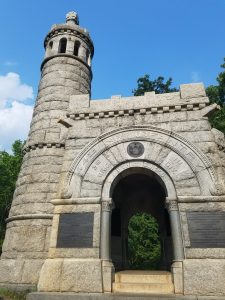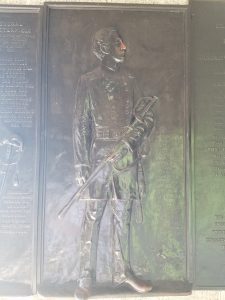Why is Barlow on Little Round Top?
 Eager to step into the shade, I climbed into the 44th New York Monument at Gettysburg which poises on the southwestern edge of Little Round Top. It’s the largest regimental monument on the battlefield and is shaped like a mini castle! Erected in 1893 by veterans of the unit and New York commission memorializing their state’s units and deeds at Gettysburg, it’s an impressive structure and an eye-catching landmark even from the other side of the battlefield.
Eager to step into the shade, I climbed into the 44th New York Monument at Gettysburg which poises on the southwestern edge of Little Round Top. It’s the largest regimental monument on the battlefield and is shaped like a mini castle! Erected in 1893 by veterans of the unit and New York commission memorializing their state’s units and deeds at Gettysburg, it’s an impressive structure and an eye-catching landmark even from the other side of the battlefield.
Inside the circular lower level, metal panels list the members of the regiment by company. I found “Scott Munson” on the list for Company E.
Turning around, two figures in relief art caught my eye. One looked vaguely familiar from Overland Campaign photographs. Wait…what…why? That’s General Francis C. Barlow. With the 44th New York of the V Corps?
At first glance, it’s the strangest place find Barlow on Gettysburg battlefield. He didn’t set foot there during the battle, and it’s not clear if he ever revisited the area post-war to take a tour and see other fighting positions. He didn’t command or direct associate with the 44th New York. On July 1, 1863, Barlow commanded the First Division of the XI Corps and went into position north of the town of Gettysburg, trying to take advantage of Blocher’s Knoll (now sometimes called Barlow’s Knoll). The divisions of the Confederate Second Corps plunged down the converging roads and pushed into Barlow’s command which, unsupported, was in an exposed position. The results were predictable, and it was not one of Barlow’s outstanding days—militarily or personally. He was wounded in the retreat and captured and spent the next two days of battle lying in field hospitals listening to the sounds of the combat; the Confederates left him behind when they retreated, still convinced that he was mortally wounded.

So…why is Barlow featured within the 44th New York Monument on Little Round Top, the opposite end of the battlefield?
Short answer: the 12th New York. (The monument is technically to both the 44th and the 12th New York.)
A few weeks ago, I wrote about Barlow’s first enlistment during the Civil War, and he joined the 12th New York State Militia for a 90 day service period. Well, the 12th New York went on without Barlow (he joined the 61st New York). And there was a second 12th New York. The unit that Barlow actually enlisted in was the 12th New York State Militia; then the 12th New York Volunteers mustered on May 8, 1861, with enlistments for two years of state service. In February 1862, a battalion of five companies did transfer from the 12th Militia to the 12th Volunteers.
Adding to the confusion of the 12ths, General Daniel Butterfield—who initially organized the Militia—briefly commanded the brigade which included the Volunteers. Apparently, this mix of unit identities which could rival the Shakespearean 12th Night, produced a minor Comedy of Errors in the Little Round Top memorial. Veterans considered the two 12ths to be the same, and so they memorialized their version of the 12th (a mix of members from the Militia and the Volunteers) alongside the 44th New York since two companies of the Volunteers were attached to the V Corps Headquarters at Gettysburg as part of the provost guard.
Thus, both Francis Barlow and Daniel Butterfield are memorialized in bronze reliefs for their connection to “the 12th”—properly the 12th Militia. The veterans decided to celebrate/commemorate these generals as a claim to fame connected to the unit.
So…no, Barlow didn’t fight on Little Round Top. He was not in the 44th New York or the 12th New York Volunteers. But he was briefly in the 12th New York State Militia…and that solves the mystery?
(Stay tuned for a crazy story about the dedication of the 44th/12th New York Monument in the coming days!)
Monument Madness! Love it!
Barlow was the son of one of the 19th Century pastors of my wife’s Church, First Unitarian in Brooklyn. he was born during his father’s pastorship of the church in Brooklyn Heights.
Fascinating piece, Sarah. Just visited Barlow’s Knoll today. Poor decision by Barlow cost a lot of Union lives. John Gordon’s post-war recollections of his alleged involvement in assisting Barlow after his wounding have caused controversy. Barlow apparently never indicated whether Gordon’s version of events was accurate. Will we ever know the truth?